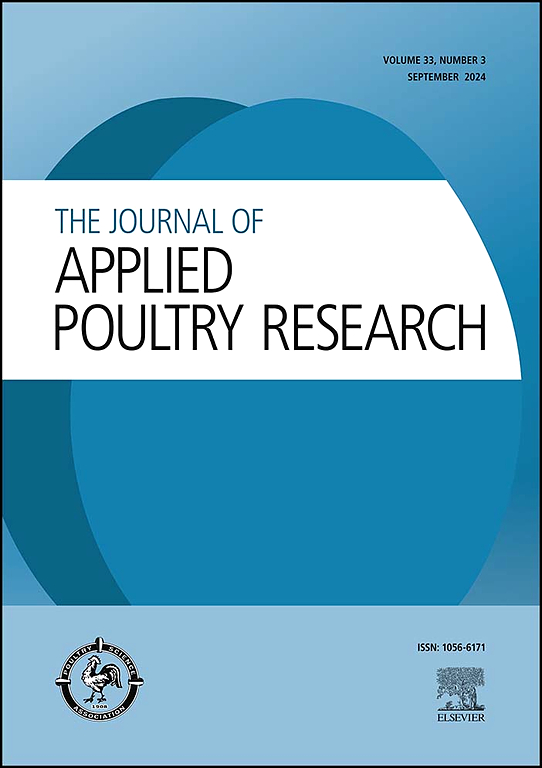低聚木糖对肉鸡生长性能影响的meta分析研究
IF 2
3区 农林科学
Q2 AGRICULTURE, DAIRY & ANIMAL SCIENCE
引用次数: 0
摘要
本荟萃分析研究利用2000年至2024年间发表的36项同行评审研究的数据,评估了低聚木糖(XOS)补充剂对肉鸡生长性能的影响。试验参数包括平均日增重(ADG)、平均日采食量(ADFI)和饲料系数(FCR)。结果表明,补充XOS可增加(P <;0.05), ADG降低6.445%,ADFI降低1.544% (P >;0.05), FCR较对照组提高7.147%。此外,添加XOS使日增重(ADG)、ADFI和FCR的变异系数(CV%)分别降低了9.386 %、5.759%和4.037%,表明生长性能的一致性增强。相关分析显示,XOS水平与ADG (R2 = 0.023, P = 0.031)和ADFI (R2 = 0.038, P = 0.009)呈显著正相关,而FCR水平与ADG (R2 = 0.004, P = 0.391)无显著相关。ADG的预测模型(R²= 0.850,RMSE = 0.135)占变异的85%,并通过交叉验证证明了其可靠性,使其成为基于XOS纳入率预测生长性能的稳健模型。该模型还强调了XOS水平与ADFI之间的显著交互作用,表明XOS的效果受采食量的影响。这些发现强调了XOS在优化肉鸡生产力和可持续性方面的潜力。然而,由于膳食成分、XOS纯度和环境条件的影响,其功效的差异值得进一步研究。本文章由计算机程序翻译,如有差异,请以英文原文为准。
Evaluating the impacts of xylo-oligosaccharides on growth performance of broiler chickens: A meta-analytical study
This meta-analytical study evaluated the impacts of xylo-oligosaccharide (XOS) supplementation on the growth performance of broiler chickens using data from 36 peer-reviewed studies, published between 2000 and 2024. The parameters analyzed included average daily gain (ADG), average daily feed intake (ADFI), and feed conversion ratio (FCR). Results demonstrated that XOS supplementation increased (P < 0.05) ADG by 6.445 % and ADFI by 1.544 %, and decreased (P > 0.05) FCR by 7.147 %, compared to the control. Furthermore, XOS supplementation reduced the coefficient of variation (CV%) for ADG, ADFI, and FCR by 9.386 %, 5.759 %, and 4.037 %, respectively, indicating enhanced consistency in growth performance. Correlation analysis revealed a significant positive association between XOS levels and both ADG (R2 = 0.023, P = 0.031) and ADFI (R2 = 0.038, P = 0.009), while FCR showed no significant correlation (R2 = 0.004, P = 0.391). A predictive model for ADG (R² = 0.850, RMSE = 0.135) accounted for 85 % of the variation and demonstrated reliability through cross-validation, making it a robust for forecasting growth performance based on XOS inclusion rates. The model also highlighted significant interactions between XOS levels and ADFI, suggesting that the effects of XOS are influenced by feed intake. These findings underscore the potential of XOS to optimize broiler productivity and sustainability. However, the variability in efficacy due to dietary composition, XOS purity, and environmental conditions warrants further investigation.
求助全文
通过发布文献求助,成功后即可免费获取论文全文。
去求助
来源期刊

Journal of Applied Poultry Research
农林科学-奶制品与动物科学
CiteScore
4.10
自引率
10.50%
发文量
80
审稿时长
104 days
期刊介绍:
The Journal of Applied Poultry Research (JAPR) publishes original research reports, field reports, and reviews on breeding, hatching, health and disease, layer management, meat bird processing and products, meat bird management, microbiology, food safety, nutrition, environment, sanitation, welfare, and economics. As of January 2020, JAPR will become an Open Access journal with no subscription charges, meaning authors who publish here can make their research immediately, permanently, and freely accessible worldwide while retaining copyright to their work. Papers submitted for publication after October 1, 2019 will be published as Open Access papers.
The readers of JAPR are in education, extension, industry, and government, including research, teaching, administration, veterinary medicine, management, production, quality assurance, product development, and technical services. Nutritionists, breeder flock supervisors, production managers, microbiologists, laboratory personnel, food safety and sanitation managers, poultry processing managers, feed manufacturers, and egg producers use JAPR to keep up with current applied poultry research.
 求助内容:
求助内容: 应助结果提醒方式:
应助结果提醒方式:


